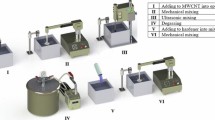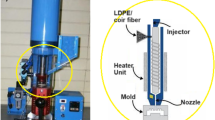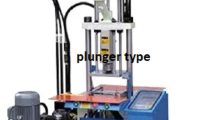Abstract
High-density polyethylene (HDPE) composites are widespread in applications such as root barriers and corrosion production pipelines due to their better chemical strength, durability, and fatigue resistance. This investigation will prepare the HDPE composite embedded with 0, 5, 10, 15, and 20 volume percentages (vol%) of carbon nanotubes via compression mold technique with the applied compressive force 100 MPa. The fabricated composite's tensile and impact strength and elongation percentage are investigated based on ASTM standards. Thus, the HDPE with 20 vol% of CNT fiber indicates the maximum tensile and impact strength of 56.3 ± 0.3 MPa and 14.8 ± 0.1 J/mm2 and elongation behavior of 148%. It is higher than the other composite prepared by compression molding. The optimum behavior of composite containing various compositions of polypropylene CNT fiber reinforced with 20% volume is recommended for lightweight and automobile applications.
Similar content being viewed by others
Explore related subjects
Discover the latest articles, news and stories from top researchers in related subjects.Avoid common mistakes on your manuscript.
Introduction
The trend for polymer composite with synthetic fiber facilitates as an alternative material for conventionally used material, and these composites are offered good elastic modulus, improved strength, better elongation, and enriched thermal and mechanical qualities [1]. The past reviews mostly studied CNT fiber with a polymer matrix to evaluate mechanical properties, better chemical resistance, good strength, and better wear resistance of the composite [2]. However, adding graphene and carbon fiber to an HDPE matrix improves extreme mechanical and thermal behavior. Using the fused filament technique has improved the quality of composite fabrication and is costly compared to other techniques [3]. The thermoplastic technique used in polyethylene to improve impact strength and mechanical properties using HDPE matrix [4]. MWCNT fiber blended HDPE composite is developed by the conventional route, and the polymer matrix composite is used with MWCNT to improve chemical resistance and exhibited better improvement of stiffness & strength using injection molding composites [5]. The past reviews of polymer matrix composite made with nanofiller of CNT fiber are summarized, and superior mechanical and thermal properties on the modified surface of the HDPE matrix are found. However, the properties of the composite may vary due to the dispersing of CNT and its physical characteristics, including size and orientation [6].
The CNT fiber-reinforced matrix used in multilayer natural fiber-reinforced composite spray coating has better strength and mechanical and adhesive properties [7]. The polymer matrix does not depend on the filler of the composite. If it is selected suitable for the composite, it improves the mechanical and thermal properties only concentrate on size and orientation [8]. HDPE and PPE with CNT fiber blended with various proportionate blended high viscosity if polyolefin is chosen to reduce dispersion and improve chemical properties [9]. The proper molding technique is used in ceramic matrix composite with CNT to achieve flexibility and stiffness. CNT blended some percentage of volume [10]. Carbon fiber-reinforced polymers are used for automobile and aircraft application multilayer coating to achieve impact resistance and compression strength [11]. The main drawbacks of conventional matrix dispersion are impact damage due to poor processing and melting. So, instead of PMC, reinforced CNT fiber should be replaced to avoid impact damage and strengthen [12] PMC with synthetic fiber epoxy material to influence compression molding to better mechanical corrosion resistance [13]. The past research conventionally improves their properties, such as metal ceramics; however, altered solutions such as polymer, Epoxy, and HDPE use CNT fiber to increase their mechanical & thermal properties [14]. However, the composite's tensile strength depends on adhesive joint strength [15] and relates to fabrication techniques [16, 17].
Composite is cited with the relevant present HDPE, and the compression mold technique suits CNT composite fabrication. The present study was executed with short CNT fiber as 0–20 vol% with 5 vol% interval blended with HDPE matrix via compression molding. ASTM standards D3039 and D256 evaluate its tensile strength, elongation percentage, and flexural strength. Evaluated results for fabricated composites showed better tensile strength and improved elongation percentage with good flexural strength.
Materials and Methods
Material
This HDPE is chosen based on improved impact strength, chemical resistance, good strength, and durability [18]. Similarly, the CNT fiber offered specific behavior, including high strength, good stiffness, durability, and better thermal stability reasons [19] as chosen by reinforcement fiber for this investigation. It is considered a 4–6-mm long chopped form during fabrication. The chopped form helps to distribute along the matrix and creates effective bonding with the matrix phase, resulting in enriched composite behavior [20]. The physical behavior of HDPE and CNT fiber is exposed in Table 1.
The combination composite details are given in Table 2. The composites are prepared by compression mold machine, and its setup is shown in Fig. 1.
This setup is operated with a hydraulic system for maximum compressive action, and the control panel controls its operating parameters. According to Table 2, the HDPE and CNT fiber is mixed with a blender machine with a low stirrer speed of 100 rpm for 10 min. After the process, thermal compression with an applied temperature of 300 °C gradually increases from the ambient temperature. The marginal improvement in temperature helps to increase the adhesive quality between the matrix and fiber [21]. After heating, its temperature is reduced to 150 °C to increase the bonding capabilities. It is compacted by the compression action of 100 MPa force for 10 min, which supports the increase in adhesive strength and removal of thermal stress. Finally, this composite is cooled by the die itself at an ambient temperature for a 3-h curing span. The fabricated composite of 150 mm × 150 mm × 10 mm is involved in mechanical behavior studies to understand the developed composite behavior and is applied in real-time applications.
HDPE Composite's Behavior Study
Fabricated HDPE composite's tensile strength/elongation behavior is investigated via an ISTRON-made universal testing machine configured with electronic plots followed by a 3-mm/min speed of the cross slide. During the evaluation, this test was preferred by the ASTM D3039 standard. Based on the ASTM D256 standards, the composite's impact strength is evaluated through the ELMACH IT30 model impact toughness measuring machine. Three trials were executed with a 5% allowable error to find test significance.
Results and Discussion
Tensile Strength of HDPE
Based on Fig. 2, the HDPE matrix of the test specimen on tensile strength C1, C2, C3, C4, and C5 contained 0–20% volume of CNT fiber-reinforced composites. Thus, HDPE matrix C1 is noted at 38.5 ± 0.5 MPa, and C2, in addition to 5% volume of CNT fiber to improved mechanical properties, and adhesive behavior between matrix and CNT fiber indicate a better tensile strength of 41.4 ± 0.3 MPa, and C3 indicates HDPE matrix sample shows 44.5 ± 0.6 MPa on 10% volume added with CNT fiber.
Then, the HDPE composite C4 specimen indicated a value of 51.6 ± 0.5 MPa. Maximum tensile strength is observed at C5 specimen 56.3 ± 0.4 MPa. They are influencing the smooth distribution of fiber. HDPE sustainable with CNT fiber shows better tensile strength, and the composite sample C5 is improved by 46.2%, related to the unreinforced HDPE matrix. The surface-treated natural fiber is the reason for the improved mechanical behavior of the composite [22].
Impact Strength of HDPE
The impact strength of the HDPE matrix (C1) and its composite specimens, such as C2, C3, C4, and C5, are shown in Fig. 3. HDPE matrix C1 specimen, the impact strength CNT fiber samples show better impact strength. The impact strength of the polypropylene matrix without CNT fiber is 9 J/mm2, and in addition, 5% volume of CNT fiber composite is identified by 11.3 J/mm2. Hence, the impact strength of composite specimens C3, C4, & C5 comprises 10, 15, & 20% of volume CNT fiber by 12.5, 13.9, and 14.8 J/mm2, respectively.
The composite sample C5 contained a maximum loading of CNT fiber specimen enhanced by 64% related to HDPE matrix C1. The surface treatment results in enriched mechanical and adhesive action and improved composite impact strength [12]. Moreover, the effective pinning action mechanism between the CNT and HDPE matrix facilitates better energy absorption capacity. It resists the fiber movement during the high-impact load, causing improved impact strength performance.
Composite Specimen on Elongation
The elongation of HDPE composite CNT fiber reinforced with 0, 5, 10, 15, and 20% volume, respectively, is shown in Fig. 4. The elongation of composite sample C1 is observed by 110%. If adding 5% of volume, CNT fiber added to composite sample C2 is noted as 118%, higher than the C1 composite specimen. With 10% of the volume of CNT fiber added to the composite specimen, the C3 sample increased by 126% on 20% of CNT fiber. Surface-treated reinforced fiber mixed with HDPE matrix resists the indentation against the load. It has better elongation [2]. In addition, the composite sample C4 contained 15 and 20% of the CNT fiber HDPE composite volume, located at 136 and 148%.
Hence, the composite sample C5 prepared with a 20% volume of CNT fiber indicated a better elongation value of 148%, hiked by 34.5% related to the C1 HDPE matrix. The enhancement of elongation is due to the appearance of hard ceramic particles exploiting superior elongation [12]. Besides, the elongation percentage of synthetic fiber (CNT) own superior value and incorporated with HDPE polymer matrix is better to adhere behavior leads to withstand the maximum tensile load and restrict the CNT fiber dislocation [5, 6].
Conclusions
The CNT fiber incorporated HDPE composite samples were developed successfully and involved tensile strength, elongation percentage, and impact strength via ASTM standard. The main conclusions are summarized in the key lists below.
-
Hence, the HDPE composite specimen prepared with various compositions and specimen C5 comprised of 20% volume of CNT fiber showed superior tensile strength, which is improved by 46.2% compared to the tensile strength of composite specimen C1 (HDPE matrix).
-
The impact strength of composite specimen C5 is exposed to 64% enhancement compared to the C1 composite specimen prepared without fiber/filler materials.
-
The elongation of composite specimen C5 is to improve by 34.5%, related to the C1 composite specimen without fiber and filler material.
-
The impact & elongation of the C5 composite specimen are recommended for lightweight automobile applications to increase tensile and micromachining plans for future studies.
Data Availability
All the data required are available within the manuscript.
References
C. Okolo et al., Carbon nanotube reinforced high-density polyethylene materials for offshore sheathing applications. Molecules 25, 2960 (2020)
B. Rao et al., Study of wear performance and mechanical properties of HDPE on the addition of CNT fillers. Mater. Today Proc. 62(14), 7501–7508 (2022)
S. Dul et al. Graphene/carbon nanotube hybrid nano composites: effect of compression molding and fused filament fabrication on properties. Polymers 12, 101 (2020).
E. Mejia et al., Effect of processing techniques on the microstructure and mechanical performance of high-density polyethylene. Polymers 13, 3346 (2021)
S. Dabees et al., Wear performance and mechanical properties of MWCNT/HDPE nanocomposites for gearing applications. Materials 12, 2476–2488 (2021)
N. M. Nurazzi et al. Mechanical performance and applications of CNTs reinforced polymer composites a review. Nanomaterials, 11, 2186 (2021).
H. U. Chao et al. The fabrication and characterization of high-density polyethylene composites reinforced by carbon nanotube coated carbon fibers. Composite 121, 149–156 (2019).
M. Tripathi et al. Enhanced thermal stability and thermophysical properties of high density polyethylene based polymer composite synthesized through compression moulding route. J. Polymer Comp. 11(5), 37591 (2023).
L. Azubuike et al., Carbon nanotube migration in a compatibilized blend system, leading to kinetically induced enhancement in electrical conductivity and mechanical properties. Nanomaterials 13, 1309 (2023)
P. Valerii et al., Methods used for the compaction and molding of ceramic matrix composites reinforced with carbon nanotubes. Processes 8, 1004 (2020)
Hu. Yunsen et al. Comparison of impact resistance of carbon fiber composites with multiple ultra-thin CNT, aramid pulp, PBO and graphene interlayers. Composite 155, 106815 (2022).
W. Christraj, Performance analysis of solar water heater in multipurpose solar heating system. Appl. Mech. Mater. 592–594, 1706–1713 (2014)
P. Raja Sekaran, Adsorption and photocatalytic degradation properties of bimetallic Ag/MgO/biochar nanocomposites. Adsorpt. Sci. Technol., Article ID 3631584, 14 pages (2022). https://doi.org/10.1155/2022/3631584
N. Karthi, Synthesis and adsorbent performance of modified biochar with Ag/MgO nanocomposites for heat storage application. Adsorpt. Sci. Technolo., Article ID 7423102, 14 pages (2022). https://doi.org/10.1155/2022/7423102
P.R. Sekaran, H. Ramakrishnan et al., Mechanical and physical characterization studies of nano ceramic reinforced Al–Mg HYBRID NANOCOMPOSITES. Silicon (2023). https://doi.org/10.1007/s12633-023-02473-9
W. Christraj, Experimental investigation of multipurpose solar heating system. J. Energy Eng. https://doi.org/10.1061/(ASCE)EY.1943-7897.0000166 (2013).
J.-Z. Liang et al., Impact and flexural properties of polypropylene composites reinforced with multi-walled carbon nanotubes. Polym. Testing 70, 434–440 (2018)
J. Venugopal et al., Effect on compression molding parameters in mechanical properties of MWCNT/glass fiber/epoxy composites. Adv. Polymer Technol. 7 (2022).
H. Rangaswamy et al., Experimental investigation and optimization of compression moulding parameters for MWCNT/glass/kevlar/epoxy composites on mechanical and tribological properties. Materials 15, 327–341 (2021)
R. Venkatesh et al., Investigation and performance study of hibiscus sabdariffa bast fiber-reinforced HDPE composite enhanced by silica nanoparticles derived from agricultural residues. Fibers Polymers, pp 1–10 (2023).
H. B. Rachid, D. Noureddine, B. Benali, M. Ş. Adin, Effect of nanocomposites rate on the crack propagation in the adhesive of single lap joint subjected to tension. Mech. Adv. Mater. Struct. 1–9 (2023). https://doi.org/10.1080/15376494.2023.2240319
S.K. Palaniappan et al., Eco-friendly Biocomposites: a step toward achieving sustainable development goals. Appl. Sci. Eng. Progress 17(4), 7373 (2024)
Funding
The authors did not receive support from any organization for the submitted work. No funding was received to assist with the preparation of this manuscript. No funding was received for conducting this study. No funds, grants, or other support were received.
Author information
Authors and Affiliations
Corresponding author
Ethics declarations
Conflict of interest
The authors have no relevant financial or non-financial interests to disclose. The authors have no competing interests to declare relevant to this article's content. All authors certify that they have no affiliations with or involvement in any organization or entity with any financial or non-financial interest in the subject matter or materials discussed in this manuscript. The authors have no financial or proprietary interests in any material discussed in this article.
Ethical Approval
This is an observational study. Development and behavior analysis of CNT fibers reinforced high-density polyethylene composite via compression mold route: The Research Ethics Committee has confirmed that no ethical approval is required.
Additional information
Publisher's Note
Springer Nature remains neutral with regard to jurisdictional claims in published maps and institutional affiliations.
Rights and permissions
Springer Nature or its licensor (e.g. a society or other partner) holds exclusive rights to this article under a publishing agreement with the author(s) or other rightsholder(s); author self-archiving of the accepted manuscript version of this article is solely governed by the terms of such publishing agreement and applicable law.
About this article
Cite this article
Venkatesh, R. Development and Behavior Analysis of CNT Fibers Reinforced High-Density Polyethylene Composite via Compression Mold Route. J. Inst. Eng. India Ser. D (2024). https://doi.org/10.1007/s40033-024-00718-4
Received:
Accepted:
Published:
DOI: https://doi.org/10.1007/s40033-024-00718-4








